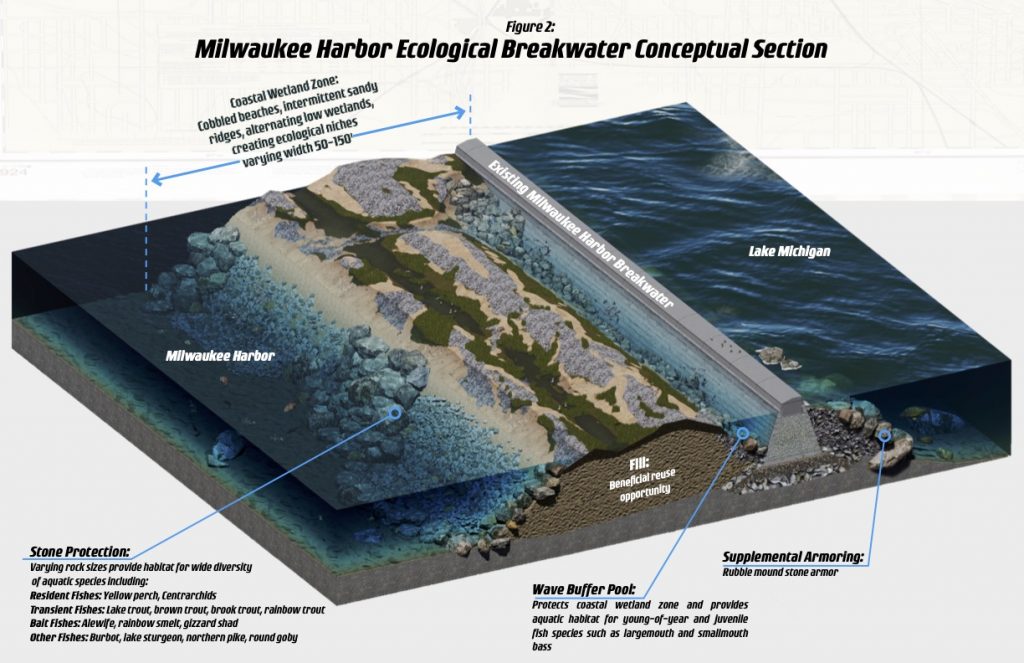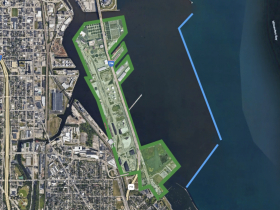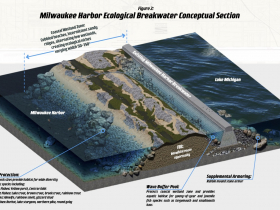‘Living Breakwater’ Would Protect Harbor
Harbor District, partnering with city, wins grant to design wetland habitat structure.
The industrial-style breakwater that protects Milwaukee’s harbor from waves and storm surges could soon look much more appealing. It would also become an environmentally-friendly habitat for wildlife and better protect the city’s waterfront.
The nonprofit Milwaukee Harbor District, in partnership with the city and the U.S. Army Corps of Engineers, received a $455,800 grant from the National Fish and Wildlife Foundation to design a “living breakwater system.” The new system, to be constructed behind the existing masonry breakwater, would be a 50-to-150-foot-wide coastal wetland zone and could include a wave buffer pool, cobbled beaches, stone fish habitats, sand ridges, low wetlands and other environmental features. It would be designed to be self-sustaining.
“This opportunity presents a generational opportunity to protect the economic assets of our community but also be a safe harbor for the plants, birds, fish and animals of our Inner Harbor,” said Harbor District CEO Tia Torhorst in a press release announcing the grant.
The initial funding will be used to develop preliminary designs and assess the current condition of the breakwater. Additional funding would need to be secured to construct the planned, half-mile-long development.
The announcement comes as the city and other partners continue to ramp up a large effort to clean up the city’s waterways and see the 1987 federal “Area of Concern” designation removed. The effort is expected to cost hundreds of millions of dollars, with much of the funding coming from the federal government.
“The City of Milwaukee strongly supports nature-based coastal resiliency solutions, and is working with partners to realize this vision,” said Mayor Cavalier Johnson in a statement. “Collaborative efforts like this are helping Milwaukee remain the freshwater capital of the world.”
“This planning grant is the first step toward building a more resilient Lake Michigan shoreline that will pay dividends for the ecological and economic health of Southeastern Wisconsin for years to come,” said U.S. Senator Tammy Baldwin.
The idea stems from a 2015 design charette convened by the city and Harbor District. The resulting infrastructure would provide a new natural habitat to support plants, birds, fish and animals as well as protect a wide array of vulnerable waterfront properties and infrastructure, including the Milwaukee Metropolitan Sewerage District‘s Jones Island treatment plant and a planned, 42-acre Dredged Material Management Facility. A January 2020 storm flooded more than half of the 467-acre port and caused more than $1.25 million in damage.
The Army Corps of Engineers sees the effort as a demonstration structure for how other Great Lakes communities could be protected. “The project, a perfect marriage of habitat and resilience goals, will build on the successful breakwater enhancement project completed in Milwaukee Harbor in 2014 and will be an excellent demonstration project,” said the group’s deputy national lead and program manager Jeff King.
The grant comes from the fish and wildlife foundation’s National Coastal Resilience Fund, a public-private partnership between the foundation, U.S. Department of Defense, Shell, reinsurance organization Transre, Oxy (Occidental Petroleum) and the National Oceanic and Atmospheric Administration.
In addition to the breakwater improvements, the city and Harbor District are jointly pursuing a 4,300-foot riverwalk extension with a host of environmental features along the Komatsu Mining South Harbor Campus property. Construction is expected to begin this year.
Milwaukee County is investing in a separate repair to the South Shore Park breakwater.
Images
More about the Area of Concern Abatement Effort
- New Machine Quietly Cleans Milwaukee’s Water - Jeramey Jannene - Mar 21st, 2025
- Photo Gallery: New South Shore Park Beach Takes Shape - Graham Kilmer - Mar 14th, 2025
- MKE County: Effort Aims To Reduce E. Coli Closures at Bradford Beach - Graham Kilmer - Feb 27th, 2025
- MKE County: Habitat Restoration Planned in Kletzsch Park - Graham Kilmer - Feb 14th, 2025
- MKE County: County Deploying $1.3 Million in Environmental Cleanup Grants - Graham Kilmer - Sep 19th, 2024
- MKE County: Habitat Restoration Coming to Kohl Park - Graham Kilmer - Jan 12th, 2024
- MKE County: Largest Fish Barrier Between Grafton and Lake Michigan Removed - Graham Kilmer - Dec 21st, 2023
- EPA Giving Milwaukee $17 Million For Sewer Project - Evan Casey - Nov 2nd, 2023
- Cleanup Of Polluted Great Lakes Sites Reverses Housing Price Declines - Danielle Kaeding - Oct 19th, 2023
- Milwaukee Wins $275 Million Grant To Fund Massive Waterway Cleanup - Jeramey Jannene - Oct 12th, 2023
Read more about Area of Concern Abatement Effort here

























Can this grant be used at McKinley Beach where we have a problem we’ve not solved?
https://urbanmilwaukee.com/2022/03/23/mke-county-dangerous-mckinley-beach-can-be-fixed/
Exciting! Sort of strange language use, though: “plants, birds, fish and animals.” Umm… birds and fishes are animals, too.
Great idea, but the illustration is scary if the proportions of the features are representative.
Taking the illustration literally, and starting at the lake side and working inward:
1) The amount of the “supplemental armoring” (big rocks) is too small to protect against scouring along the bottom of the existing breakwater. Adding more rocks however, will drive more water over the top due to displacement.
2) The wave buffer pool/trough will be agitated if not turbulent, when waves come over. I’m not sure what species would find that attractive as refuge or habitat. Connections to calmer waters in the fill zone and harbor would help that.
3) More medium/big rocks may be needed on the lakeward edge of the fill to prevent turbulence erosion during storms.
4) The Fill Zone surface should be as wide as circumstances allow and provide a wide range of habitat features.
As climate changes, so will the species composition. Also there are species that – regardless of habitat suitability – will always stay a certain minimum distance inside the boundary of that habitat. Even trees should be accommodated by soil areas protected from wave action and even flooding (Over time, water level is always variable).
Conditions in the lake and harbor waters will also determine the breakwater’s population.
5) | The Fill Zone’ s “inner bank’s” varied rocks feature sounds good.
I hope the nearby pollution dumpsite doesn’t leak into the harbor and that a polluting ship catastrophe doesn’t happen. The cleanup of such a feature would be an expensive headache.
Otherwise, I like it. Do it
The proposed breakwater expansion will increase the habitat for the seagulls. They already do a fine job of turning the existing walls white and their fragrance will make you forget the odors from the sewerage treatment facility.
A large population of geese at South Shore beach have demonstrated the environmental damage they create. Will this project have the same results with contaminated water high in nutrients for algae and weeds to grow creating another foul-smelling area along the coast?
The city or county will need to address removal of debris and trash from the half mile long area. Both governments already have budget shortfalls and cannot maintain their existing parks. More efforts are needed to stop the up-stream pumping of
raw sewerage into the Milwaukee river that join other discharges that empty into the inner harbor.
Back to the birds. With a new habitat acting as the birds lake home will there be an increase number of birds flying sorties to Summerfest or their high rise residences under the Hoan bridge? Will there be an increase of guano on cars, structures and parking lots along the coast? Who will control the air traffic between birds and planes in the flight path to/from Mitchell International Airport?
I agree that improvements are needed along the lake-front, but I question the viability of this project.
Re: Jeff Konkel says:
I completely forgot about the ‘dump chickens’
(Wi DNR dept. vocabulary)
I’m not an ornithologist, but I thought
the trees might attract fishing birds.
A quick lookup of seagull predators brought
up 3 candidates – Falcons, Eagles
and weasels.
Milwaukee is hosting Falcons downtown, and Eagles
have been seen near and possibly in Milwaukee,
over 15 years ago. I’ve not kept up on any
areas they’re attracted to. If the Milwaukee River
green areas and Eastside parks don’t already have
them, they may be avoiding noise, pollution or people.
On the breakwater, maybe boats instead of people would
drive them away. Or the diet conveniently available there.
That leaves weasels, which may make sense on an island
habitat. If the Falcons and Eagles don’t eat ’em,
they could eat eggs or race with the seagulls
to grab wave-stranded fish.